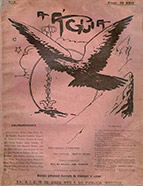

................................
Notably, from its very first issue, A Águia showed a strong interest in themes related to social justice and popular education. The republican revolution likely rekindled this interest, inspiring hope among the magazine’s contributors for political change that would lead to substantial improvements in living conditions. In the inaugural issue of December 1910, Teixeira de Pascoaes, in a column aptly titled Justiça Social [Social Justice], discussed the precarious situation of tenant farmers, while Leonardo Coimbra underscored the social role of education, and Raul Proença examined the social significance of art. In the second issue, Ângelo Vaz reflected on children and the Republic, arguing that the degree of civilisation in a modern society could be measured by the care given to disadvantaged children — an area that republican Portugal was now tasked with developing. In the fifth issue, dated 1 February 1911, Leonardo Coimbra addressed the issue of education, stressing the urgent need to provide the Portuguese people, backward in many respects, with profound spiritual wealth through knowledge. Most contributors to the first series of A Águia called for the mobilisation of artists and intellectuals, believing that art could serve as a practical exercise in educating for freedom. Moreover, they saw the promotion of the arts as a strategy for fostering social and national solidarity and cohesion (Norberto Cunha, “A Génese da Renascença Portuguesa perante a crise política e moral da I República”, Crises em Portugal nos século XIX e XX, p. 160).
When it became the organ of the Portuguese Renaissance movement, A Águia increasingly voiced a vision for transforming the country on moral, intellectual, and spiritual levels, alongside material and economic renewal. Central to the Portuguese Renaissance was the sentiment that the Republic lacked “renewing and fruitful content” (Pinharanda Gomes, A Renascença Portuguesa - Teixeira Rego, p. 17). At the launch of the second series in January 1912, Pascoaes outlined the direction of the magazine he had come to lead (he would step down in 1917, after which the publication began to decline in substance and content). He emphasised his search for a guiding path for the intellectual energies of the Portuguese people, “to create a new Portugal, or rather to resurrect the Portuguese homeland” ("Renascença", Águia II series, Issue 1, January 1912, pp. 1-3). The renewal efforts undertaken by the Portuguese Renaissance were not limited to invigorating periodicals such as A Águia or Vida Portuguesa (published between 1912 and 1915 under the direction of Jaime Cortesão). Portuguese culture was also promoted among workers, shopkeepers, and other segments of society, not only through extensive editorial efforts, resulting in the publication of nearly three hundred works, but also through popular universities, conferences, and reading sessions held across various regions. At A Águia , Teixeira de Pascoaes found an ideal platform to express his nostalgic vision. Characterised by the poet from Amarante as the 'eternal personality of the race' and a 'rebirth through the emotional instinct of the people,' Saudade — a metaphysical, philosophical, and political concept expressing the Lusitanian soul — sought to regenerate a decaying country, reviving its splendour and fortifying Portuguese identity with the spirit of the Discoveries ( O Espírito Lusitano ou o Saudosismo , 1912.). Advocating for popular education and social justice while opposing foreign influences perceived as incompatible with the Portuguese ethnic character, Pascoaes campaigned for a national restoration rooted in moral and spiritual values (“Ao Povo Português – A Renascença Portuguesa”, Vida Portuguesa, Issue 22, 10/2/1914, pp. 10-12). Pascoaes not only saw the homeland as a spiritual entity but believed that Portugal could only be free by remaining authentically Portuguese, as it had been in the age of the Discoveries, an era marked by the bravery of the Lusitanians. Thus, to recover national identity, he argued for strengthening a connection to origins, reinforcing the teaching of Portuguese history, and cultivating attachment to rural life. In affirming a messianic vision of destiny, he placed faith and will above rational criteria (Norberto Cunha, “A Génese da Renascença Portuguesa perante a crise política e moral da I República”, p. 164). Though Pascoaes played a dominant role in the magazine, other authors associated with the Renascença were also devoted to forms of national restoration or renewal. While they did not disregard matters of spirit and soul, they placed greater emphasis on material development.
This work is financed by national funds through FCT - Foundation for Science and Technology, I.P, in the scope of the projects UIDB/04311/2020 and UIDP/04311/2020.
